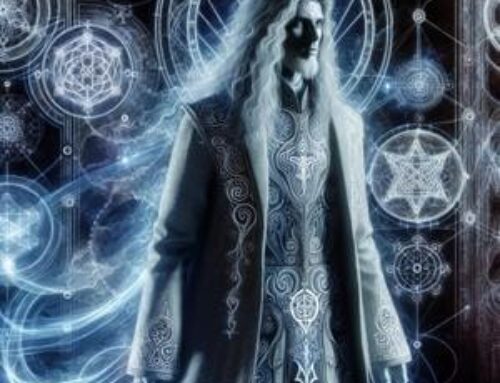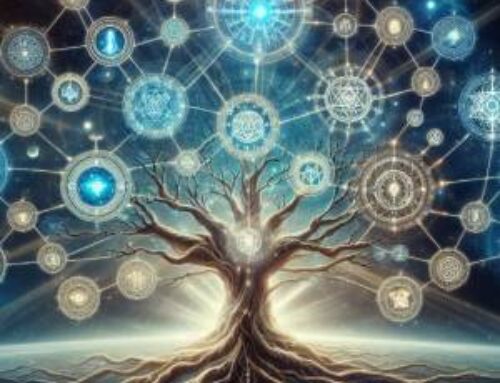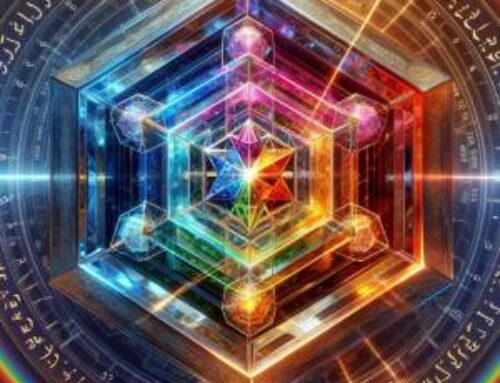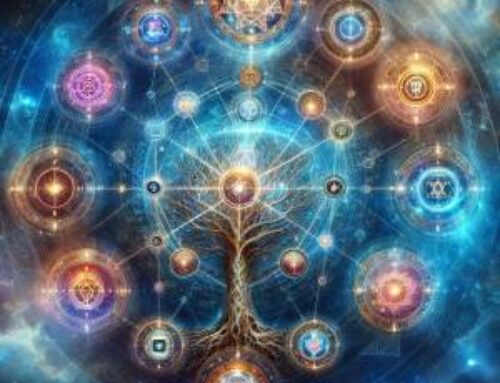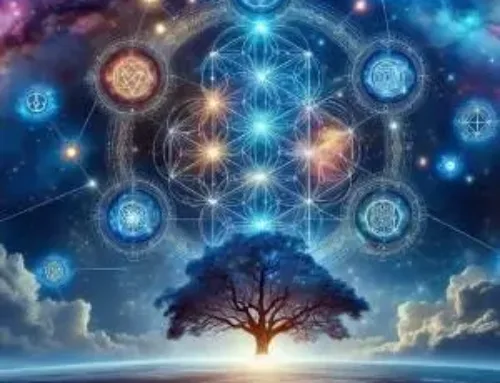Contents
- 1 Introduction to Qliphoth Kabbalah
- 2 The Qliphoth in Kabbalistic Cosmology
- 3 Navigating the Unbalacend Emanations
- 4 The Divine Act of Tzimtzum and Its Shadow
- 5 The Seeker’s Path in the Qliphoth
- 6 Practical Kabbalah and the Qliphoth
- 7 Bridging Timeless Wisdom with Contemporary Seekers
- 8 Conclusion
- 9 FAQ – Qliphoth Kabbalah
- 9.1 1. What is Qliphoth Kabbalah?
- 9.2 2. How does Qliphoth Kabbalah differ from traditional Kabbalah?
- 9.3 3. Is Qliphoth Kabbalah considered dangerous?
- 9.4 4. Can anyone study Qliphoth Kabbalah?
- 9.5 5. What are the benefits of studying Qliphoth Kabbalah?
- 9.6 6. How does one begin studying Qliphoth Kabbalah?
- 10 References:
Introduction to Qliphoth Kabbalah
Navigating the intricate architecture of Kabbalistic wisdom necessitates an understanding of its more obscure components, notably the Qliphoth Kabbalah. Contrary to the luminous emanations of the Sephiroth, the Qliphoth Kabbalah represents the shadowy vestiges of spiritual illumination, embodying the principle of necessary antithesis in the cosmic balance. It is here, within this arcane framework, that the hidden dimensions of spiritual adversity and moral complexity are encountered. The Qliphoth Kabbalah, often perceived through a lens of caution and reverence, emerges not as a mere repository of negativity but as a crucial facet in the quest for spiritual wholeness.
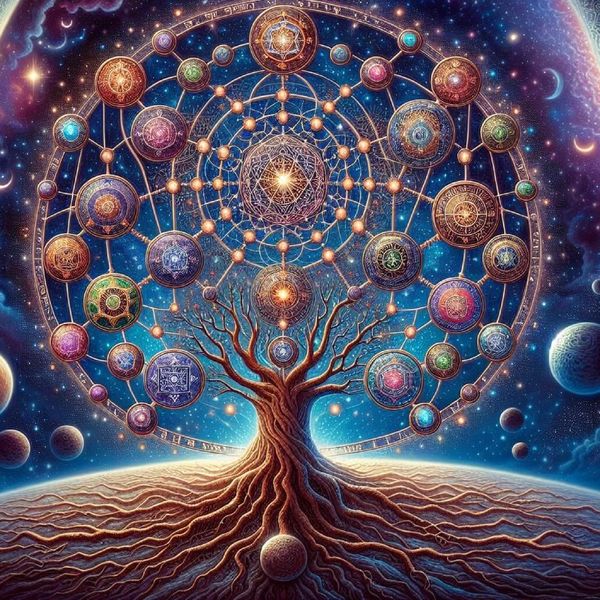
The Kabbalah always calls the evil elemental spirits of matter ‘shells.'” (On the concept of ‘shells’ or ‘Qliphoth’, representing negative forces or entities in Kabbalistic thought) (1).
The study of the Qliphoth Kabbalah is a venture into the profound depths of spiritual duality, revealing the essential role of darkness in the pursuit of light. Through this exploration, one confronts the primordial forces of creation and dissolution, engaging with the aspects of the self and the divine that are often left unexamined. This engagement deepens our understanding of the spiritual path, highlighting the necessity of integrating the lessons of the Qliphoth Kabbalah into our journey towards enlightenment.
In Kabalistic symbolism, the representation of God is always by a duplicated image — one erect, the other reversed; one white and the other black (2).
The lore of the Qliphoth challenges the aspirant to transcend mere dichotomies of good and evil, inviting a nuanced comprehension of their interplay within the fabric of existence. It is in this realm that the adept encounters the paradoxes central to Kabbalistic mysticism, where the boundaries between light and shadow blur, leading to a transcendent synthesis of wisdom.
Thus, the exploration of the Qliphoth Kabbalah is not an end in itself but a passage through the shadowed realms of consciousness, guiding the seeker towards a more profound reconciliation with the totality of being. In embracing the lessons of the Qliphoth, one embarks on a transformative process, wherein the integration of shadow becomes a conduit for spiritual renewal and ultimate unity with the divine.
The Qliphoth in Kabbalistic Cosmology
At the heart of Kabbalistic cosmology lies the intricate structure of the Tree of Life, a symbol comprising ten emanations or Sephiroth. Each Sephirah (Hebrew: SPhYRH) embodies an aspect of divine will, a stepping stone in the descent of divine light into the material world. However, mirroring this tree of light, there exists a shadowy counterpart known as the Qliphoth (Hebrew: QLYPVTh) or “Shells.” These entities represent the husks of potentiality that were not actualized in the creation process, serving as vessels for the aspects of existence that diverge from the divine blueprint.
Kabbalah is a mystical and intellectual branch of Judaism that, since the Middle Ages, has explored the mysteries of God, sought mystical union with God, and harnessed divine energy for the betterment of the world (3).
The Realm of Duality
The Qliphoth Kabbalah, therefore, is not merely a collection of demonic entities but a fundamental aspect of Kabbalistic thought that underscores the presence of duality within creation. It symbolizes the necessary balance between light and darkness, revealing that spiritual growth encompasses both the ascent towards divine illumination and the descent into the depths of one’s inner shadows.
The Tree of Death
Often referred to as the Tree of Death, the Qliphoth’s ominous moniker belies its integral role in the spiritual journey. This realm challenges the seeker to confront and integrate the lessons hidden within their shadows, an essential process for achieving spiritual wholeness. The Qliphothic path is fraught with peril, not because it leads the practitioner into evil, but because it forces an encounter with the unrefined, raw aspects of the self that are usually shunned or repressed.
The Forces Within the Qliphoth Kabbalah
Each Qlipha, singular for Qliphoth, inversely mirrors a Sephirah, embodying its distorted reflection. These dimensions host a myriad of spirits and entities that personify the qualities of the divine gone awry. Understanding these forces offers insights into the nature of spiritual corruption and the perversion of divine attributes, serving as cautionary tales for those who navigate the spiritual path.
Embracing the Darkness
The exploration of the Qliphoth Kabbalah is not an endorsement of malevolence but an acknowledgment of the complexity of the divine creation. By venturing into the Qliphoth, the mystic seeks to reclaim and redeem these fallen sparks of light, integrating them into the fabric of their spiritual being. This process is emblematic of the Hermetic axiom “As above, so below,” where the microcosm reflects the macrocosm, and the journey towards enlightenment involves the reconciliation of all dichotomies.
In the enigmatic realm of the Qliphoth, each dark emanation serves as a shadowy counterpart to the luminous Sephiroth of the Tree of Life. These entities, far from being mere negations of divine qualities, embody the aspects of creation that have strayed from their original purity. The hierarchy within this realm is complex, with each Qlipha governed by entities that reflect the inverse qualities of their divine counterparts.
Samael and Lilith
Central to the infernal hierarchy are Samael, often referred to as the Adversary, and Lilith, the Night Hag or the first wife of Adam, according to certain myths. Together, they preside over the Qliphoth, embodying the antithesis of divine unity and harmony. Samael’s association with severity and judgment, when corrupted, turns into tyranny and oppression, while Lilith’s freedom and independence, in their shadow aspect, manifest as isolation and rebellion without cause.
The Role of the Dark Archangels
Each Qlipha is also associated with dark archangels, beings that mirror the attributes of the archangels of the Sephiroth but through a lens darkly. These entities challenge the seeker to confront the distortions within their nature and the cosmos, embodying the trials that must be overcome to achieve spiritual maturity. Understanding these dark archangels provides a nuanced view of the spiritual struggle between light and shadow.
A Journey Through Shadows
The paths connecting the Qliphoth, much like those on the Tree of Life, represent the journey through various states of being that lead towards enlightenment. However, in the realm of the Qliphoth, these paths are fraught with illusions and traps, testing the adept’s resolve and purity of intent. Navigating this landscape requires not only courage but a profound understanding of the nature of duality and the reconciliation of opposites.
The Dangers and Misconceptions
While the exploration of the Qliphoth offers profound insights into the nature of fallen creation and the process of redemption, it is fraught with dangers. Misinterpretations and fear have shrouded this aspect of Kabbalistic study in mystery and taboo. Yet, for the adept, the infernal hierarchy illuminates the necessity of confronting and integrating the shadow, emphasizing that true spiritual elevation transcends the simplistic dichotomy of good versus evil.
The Divine Act of Tzimtzum and Its Shadow
Tzimtzum, (Hebrew: TzMTzVM) a concept pivotal to Kabbalistic thought, describes the self-imposed contraction of the Ain Soph Aur (Hebrew: AYN SVPh AVR), the Infinite Light, to allow the existence of something other than Itself. This metaphysical event creates a a space in which the finite realms can manifest, laying the groundwork for creation and the subsequent emanation of the Sephiroth. However, within this act of divine limitation lies the seed for the emergence of the Qliphoth.
The Emergence of the Qliphoth
As the divine light recedes, the remnants, or “shells” (Qliphoth), are left in the void. These are not merely residues but represent the potentialities and aspects of creation that are not actualized within the Sephiroth. The Qliphoth, therefore, embodies the necessary contrast to creation’s ordered structure, a realm where the rejected and unmanifested aspects of the divine will reside.
The Balance of Creation and Void
The concept of Tzimtzum underscores the delicate balance between being and non-being, presence and absence, creation and void. This balance is mirrored in the relationship between the Tree of Life and its shadow, the Tree of Death. The Qliphoth exists as a testament to the limits of divine expression and the complexities of the creative process, highlighting the interdependence of light and darkness in the fabric of existence.
The realm of the Qliphoth challenges the seeker to navigate through the spaces where the divine light is not apparent, to confront and integrate the aspects of the self and the divine that are hidden in shadow. This journey is not one of descent into evil but an exploration of the full spectrum of divine potential, including that which is beyond the immediate presence of the divine light.
The Role of the Qliphoth in Spiritual Evolution
Understanding the role of the Qliphoth in relation to Tzimtzum offers profound insights into the nature of spiritual evolution. It reveals that the path to divinity encompasses both the illumination of the Sephiroth and the shadowy realms of the Qliphoth. The integration of these aspects signifies the maturation of the soul, as it learns to navigate and harmonize the dualities of existence.
The Seeker’s Path in the Qliphoth
In the quest for spiritual enlightenment, the path through the Qliphoth represents a profound challenge and a paradoxical invitation. This journey into the shadow realms of Kabbalah is not a descent into depravity but a deliberate confrontation with the aspects of self and existence that are typically shunned or ignored. The Qliphoth, with its intricate landscape of darkness, offers a unique opportunity for growth, demanding courage, introspection, and the willingness to face one’s deepest fears.
The Nature of Shadow Work
Shadow work within the context of the Qliphoth involves the integration of the darker facets of the psyche into conscious awareness. This process is akin to retrieving the “lost sparks” of divine light trapped within the shells of the Qliphoth. By recognizing and embracing these shadow elements, the seeker initiates a process of internal alchemy, transforming potential sources of weakness into strengths and moving closer to a state of wholeness.
The Guidance of the Dark Archetypes
The entities and archetypes encountered within the Qliphoth serve as both adversaries and guides. Each embodies a distortion of the divine attributes, reflecting the ways in which these qualities can be misaligned. Through engagement with these forces, the seeker is challenged to discern the difference between genuine spiritual insight and the illusions cast by the shadow. This discernment is crucial for navigating the Qliphothic realm and for the broader spiritual journey.
The Integration of Light and Shadow
The ultimate goal of traversing the Qliphoth is not to dwell within darkness but to achieve a deeper understanding and integration of the self. This journey underscores the Kabbalistic teaching that true enlightenment encompasses both the light of the Sephiroth and the darkness of the Qliphoth. It is through the reconciliation of these polarities that the seeker can attain a state of spiritual balance and harmony.
The Alchemy of Transformation
The path through the Qliphoth is an alchemical process, whereby the seeker’s engagement with the shadow becomes the crucible for spiritual transformation. This journey demands resilience, compassion, and a profound commitment to self-discovery. The rewards, however, are immeasurable, offering insights into the nature of the self, the divine, and the interconnectedness of all existence.
Practical Kabbalah and the Qliphoth
Practical Kabbalah extends beyond theoretical study, inviting initiates to actively engage with the spiritual forces and structures it describes. This engagement is particularly profound when it involves the Qliphoth, the shadowy reflection of the Tree of Life. Here, practitioners confront the aspects of themselves and the cosmos that are typically veiled in darkness, embarking on a transformative journey that demands both wisdom and caution.
Techniques for Shadow Integration
To navigate the Qliphoth, several esoteric practices are employed, each designed to safely engage with and integrate the lessons of the shadow. These include meditative journeys guided by the paths between the Qliphothic spheres, rituals aimed at confronting personal fears and limitations, and the use of sigils and names of power to communicate with the entities residing within these realms. Such practices require a deep grounding in Kabbalistic philosophy and a clear intention to foster spiritual growth rather than mere curiosity.
The Role of the Magician or Mystic
The practitioner, whether identified as a magician, mystic, or Kabbalist, approaches the Qliphoth with a dual aim: to reclaim the lost divine sparks within the shadows and to achieve a personal synthesis of light and darkness. This work is not for the faint-hearted or the unprepared; it necessitates a solid foundation in spiritual protection techniques, a balanced psychological state, and an unwavering ethical compass to navigate its complexities without succumbing to the inherent risks.
Ethical Considerations and Dangers
Engagement with the Qliphoth carries significant risks, including psychological upheaval and spiritual delusion. The entities and forces encountered can be deceptive, reflecting the practitioner’s unacknowledged desires or fears. Therefore, ethical considerations are paramount, ensuring that the work undertaken serves the higher purpose of enlightenment and the healing of the soul, rather than the pursuit of power or escape from personal shadow work.
The Path of Return: Integration and Wisdom
The ultimate purpose of engaging with the Qliphoth in practical Kabbalah is not to remain within the realm of shadows but to integrate the insights gained into one’s spiritual practice and daily life. This integration is a path of return, leading the practitioner back to the light of the Sephiroth with a deeper understanding of the unity and balance that underlies all existence. Through this journey, the mystic becomes a vessel for the divine, capable of transforming darkness into light, not only within themselves but in the world around them.
The High Art of Evocation
Only the most advanced adepts are equipped to navigate the treacherous terrains of the Qliphoth, undertaking the monumental task of dismantling the shells to liberate and redirect their power towards the Sephirothic levels. This profound work is far beyond the reach of novices who, guided by texts riddled with misconceptions, dare to venture unprepared into these shadowed realms.
Establishing contact with the Higher Self is a prerequisite for engaging with the Qliphoth; without this vital connection, the unwary practitioner risks being ensnared by illusions, falling prey to the deceptive forces that lurk within, and succumbing to the dominion of malevolent energies. The high art of evocation transcends the misconceptions found in books, being mastered only through a structured curriculum under the guidance of an authentic and connected lineage of a mystery school, such as the Hermetic Academy.
Bridging Timeless Wisdom with Contemporary Seekers
In the ever-evolving landscape of modern esotericism, the Qliphoth Kabbalah occupies a fascinating and vital position. Contemporary practitioners of Kabbalah and related mystical traditions are increasingly drawn to the exploration of these shadow realms, not as mere subjects of dark curiosity but as essential aspects of spiritual wholeness and self-discovery. This renewed interest marks a shift towards a more holistic understanding of mystical practices, where the integration of shadow elements is recognized as pivotal for genuine spiritual advancement.
Conceptual Engagements with the Qliphoth
Today’s esoteric scholars and practitioners approach the Qliphoth with a nuanced understanding that transcends earlier interpretations of these realms as purely malevolent. Instead, they are seen as vital to the balance of cosmic and personal energies, offering a profound counterbalance to the Sephiroth’s light. This conceptual engagement with the Qliphoth reflects a broader trend in modern spirituality that acknowledges the importance of confronting and integrating the shadow for authentic growth and transformation.
Practical Applications and Safeguards
Practically, the engagement with the Qliphoth Kabbalah among contemporary mystics involves a variety of ritualistic and meditative practices designed to safely explore these realms. These practices are often grounded in the rich tapestry of traditional Kabbalistic methods but are adapted to suit the needs and understandings of modern seekers. Importantly, this work is undertaken with a keen awareness of the potential dangers, emphasizing the necessity of guidance from experienced teachers and the protective frameworks provided by established mystical lineages, such as those of the Hermetic Academy.
The Role of the Qliphoth in Personal Transformation
For many in the contemporary mystical community, working with the Qliphoth Kabbalah is part of a broader journey towards self-knowledge and spiritual enlightenment. This involves recognizing and transforming the shadow aspects within oneself, a process that is both challenging and deeply rewarding. By engaging with the Qliphoth, practitioners seek to reclaim and integrate the disowned parts of themselves, thus achieving a greater sense of wholeness and harmony.
The Qliphoth in Collective Spiritual Evolution
On a collective level, the engagement with the Qliphoth reflects a maturing spiritual landscape where dualistic notions of good and evil are transcended in favor of a more integrated and complex understanding of existence. This perspective is crucial in an age characterized by polarization and fragmentation, offering a path towards unity that embraces the full spectrum of human and cosmic potential.
Conclusion
The exploration of the Qliphoth within the context of Kabbalah offers a profound journey that transcends conventional notions of spirituality, challenging seekers to confront and integrate the darker facets of existence into their quest for enlightenment. This path, fraught with complexities and paradoxes, demands not only courage but a deep commitment to the principles of self-awareness and transformation.
The Qliphoth Kabbalah, with its intricate architecture of shadows, serves as a powerful reminder of the non-dual nature of reality, where light cannot exist without darkness, and spiritual growth is contingent upon the integration of both. Through engaging with the Qliphoth, practitioners are offered the opportunity to reclaim lost parts of themselves, transforming shadow into a source of strength and wisdom.
This journey is not for the uninitiated or the faint-hearted. It requires a solid foundation in mystical practice, a resilient spirit, and guidance from those who have navigated these realms successfully. The Hermetic Academy, as a bastion of authentic esoteric wisdom, provides a sanctuary for those drawn to the mysteries of the Qliphoth Kabbalah, offering a structured path of study that ensures safe and meaningful engagement with these potent forces.
As we stand at the threshold of a new era in spiritual practice, the Qliphoth’s teachings offer invaluable insights for those seeking to navigate the complexities of modern existence. By embracing the full spectrum of our being and acknowledging the indispensable role of the shadow in our spiritual evolution, we can step into a more integrated and harmonious relationship with the cosmos.
Enter the Authentic Path of the True Adept
Step into the realm of profound understanding and personal transformation with the Hermetic Academy. Explore the intricate mysteries of initiatory and magical Kabbalah, including the insightful teachings of the Qliphoth, guided by experienced adepts (4). Unveil the balance between light and shadow through a curriculum rooted in authentic esoteric wisdom.
FAQ – Qliphoth Kabbalah
1. What is Qliphoth Kabbalah?
Qliphoth Kabbalah refers to the study and exploration of the “other side” of the Kabbalistic Tree of Life, focusing on the shadowy realms known as the Qliphoth. These are considered the inverse or negative emanations, representing aspects of existence that diverge from the divine blueprint.
2. How does Qliphoth Kabbalah differ from traditional Kabbalah?
While traditional Kabbalah centers on the Sephiroth or the positive emanations of the Tree of Life, Qliphoth Kabbalah delves into the shadow aspects and the realms that exist beyond the immediate presence of divine light. It emphasizes understanding and integrating the darker facets of existence into one’s spiritual journey on the path of Magic of Light.
3. Is Qliphoth Kabbalah considered dangerous?
Qliphoth Kabbalah can be challenging due to its focus on shadow elements and the potential for encountering deceptive forces. It requires solid grounding in spiritual practices, ethical integrity, and the guidance of adepts of an authentic initiatory mystery school to navigate safely.
4. Can anyone study Qliphoth Kabbalah?
While the study of the Sephiroth Kabbalah is open to many seekers of esoteric wisdom, the theoretical and practical work with the Qlipoth Kabbalah is reserved for those adepts, who are well prepared and have established contact and communication with the Higher Self.
5. What are the benefits of studying Qliphoth Kabbalah?
Studying Qliphoth Kabbalah offers deep insights into the nature of spiritual duality, providing a more comprehensive understanding of the cosmos and oneself. It is the magical Kabbalah and mastering Light and Darkness.
6. How does one begin studying Qliphoth Kabbalah?
Beginning studies in Qliphoth Kabbalah should be approached with caution, ideally under the guidance of reputable institutions, such as those found within the Hermetic Academy. These provide structured and safe exploration of these teachings.
References:
(1) Mathers, S. L. M. (1887). The Kabbalah Unveiled. London: George Redway.
(2) Eliphas Levi. (1854). Dogme et Rituel de la Haute Magie. Paris, Frankreich.
(3) Tirosh-Samuelson, H. (2013). Kabbalah in Judaism. . https://doi.org/10.1007/978-1-4020-8265-8_1519.
(4) Rubenstein, E. (2020). The Tree of Life: The Kabbalah of Immortality. Hermetic World, Paphos.

